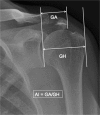The acromial index is not predictive for failed rotator cuff repair
- PMID: 23793462
- PMCID: PMC3824894
- DOI: 10.1007/s00264-013-1963-9
The acromial index is not predictive for failed rotator cuff repair
Abstract
Background: The main objective of this study was to evaluate the association between the acromial index (AI) and the incidence of recurrent tears of the rotator cuff (RC) in a cohort of patients with full thickness tears who underwent arthroscopic primary repair.
Methods: A prognostic study of a prospective case series of 103 patients with full thickness RC tears was undertaken. The average age was 59.5 years (39-74) and follow-up was 30.81 months (12-72). True anterior-posterior X-rays were obtained during the pre-operative evaluation. Pre and post-operative magnetic resonance imaging (MRI) were recorded.
Results: Eighteen cases with recurrent tears (17.4%) were seen on post-operative MRI. The average AI for patients with recurrent tears was 0.711 ± 0.065 and for patients without recurrent tears 0.710 ± 0.064 (p < 0.05). A positive association between age and recurrent tears of the RC was noted (average ages: recurrent tears group 63 ± 5.9 years; group without recurrent tears 58.8 ± 7.5 years) (r = -0.216; p = 0.029). We did not find an association between size of the primary tear and recurrent tears (r = -0.075; p < 0.05) or between degrees of retraction of the primary and recurrent tears of the cuff (r = -0.073; p < 0.05). We observed that 38.9% of the recurrent tears cases presented with more than one tendon affected before the arthroscopy. At follow-up, none of these recurrent tears showed more than one tendon affected on MRI evaluation.
Conclusion: In this study, we found that the AI radiological measurement is not a predictor for recurrent tears of the RC after primary arthroscopic repair.
Figures


References
-
- Pfalzer F, Endele D, Huth J, Bauer G, Mauch F. Clinical and MRI results after arthroscopic rotator cuff repair using the double-row technique. A consecutive study. [Klinische und magnetresonanztomographische Ergebnisse nach arthroskopischer Rotatorenmanschettenrekonstruktion in “Double-row”-Technik. Eine serielle Studie] Obere Extremitat. 2011;6(4):267–274. doi: 10.1007/s11678-011-0117-1. - DOI
-
- Papadopoulos P, Karataglis D, Boutsiadis A, Fotiadou A, Christoforidis J, Christodoulou A. Functional outcome and structural integrity following mini-open repair of large and massive rotator cuff tears: a 3-5 year follow-up study. J Shoulder Elbow Surg. 2011;20(1):131–137. doi: 10.1016/j.jse.2010.05.026. - DOI - PubMed
-
- Miller BS, Downie BK, Kohen RB, Kijek T, Lesniak B, Jacobson JA, Hughes RE, Carpenter JE. When do rotator cuff repairs fail? Serial ultrasound examination after arthroscopic repair of large and massive rotator cuff tears. Am J Sports Med. 2011;39(10):2064–2070. doi: 10.1177/0363546511413372. - DOI - PubMed
MeSH terms
LinkOut - more resources
Full Text Sources
Other Literature Sources
Medical

